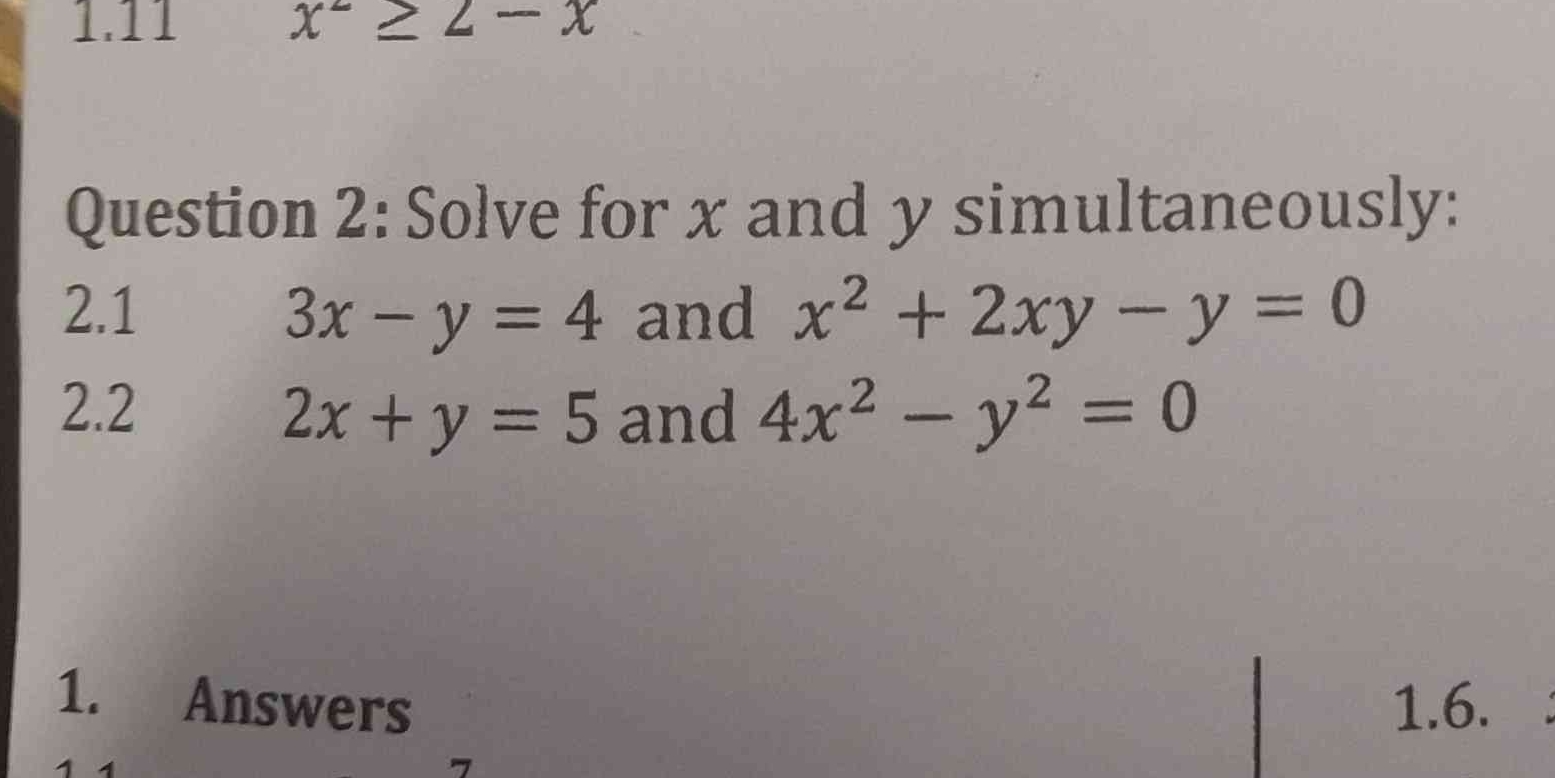Solve for x and y simultaneously: 3x - y = 4 and x^2 + 2xy - y = 0; 2x + y = 5 and 4x^2 - y^2 = 0.

Understand the Problem
The question is asking to solve two sets of equations simultaneously for the variables x and y. The first set consists of a linear equation and a quadratic equation, while the second set also contains a linear equation and a quadratic equation.
Answer
The solutions are \( (1, -1) \), \( \left(\frac{4}{7}, -\frac{16}{7}\right) \), and \( \left(\frac{5}{4}, \frac{5}{2}\right) \).
Answer for screen readers
The solutions for the equations are:
- For the first set: ( (x, y) = (1, -1) ) and ( \left(\frac{4}{7}, -\frac{16}{7}\right) )
- For the second set: ( (x, y) = \left(\frac{5}{4}, \frac{5}{2}\right) )
Steps to Solve
- Solve the first linear equation for y
Starting with the first linear equation from 2.1:
$$ 3x - y = 4 $$
Rearranging this gives us:
$$ y = 3x - 4 $$
- Substitute y in the quadratic equation
Now, substitute (y) in the second equation from 2.1:
$$ x^2 + 2xy - y = 0 $$
Substituting (y) gives:
$$ x^2 + 2x(3x - 4) - (3x - 4) = 0 $$
This simplifies to:
$$ x^2 + 6x^2 - 8x - 3x + 4 = 0 $$
So we have:
$$ 7x^2 - 11x + 4 = 0 $$
- Solve the quadratic equation for x
Now we can use the quadratic formula:
$$ x = \frac{-b \pm \sqrt{b^2 - 4ac}}{2a} $$
Here, (a = 7), (b = -11), and (c = 4):
$$ x = \frac{11 \pm \sqrt{(-11)^2 - 4(7)(4)}}{2(7)} $$
$$ x = \frac{11 \pm \sqrt{121 - 112}}{14} $$
$$ x = \frac{11 \pm \sqrt{9}}{14} $$
Which results in:
$$ x = \frac{11 \pm 3}{14} $$
- Calculate the possible values for x
Solving this gives two values:
$$ x_1 = \frac{14}{14} = 1 $$
$$ x_2 = \frac{8}{14} = \frac{4}{7} $$
- Find corresponding y values
For each (x), find (y) using (y = 3x - 4):
- For (x = 1):
$$ y = 3(1) - 4 = -1 $$ - For (x = \frac{4}{7}):
$$ y = 3\left(\frac{4}{7}\right) - 4 = \frac{12}{7} - \frac{28}{7} = -\frac{16}{7} $$
- Solve the second set of equations
Now we take the second set from 2.2:
-
$$ 2x + y = 5 $$
-
$$ 4x^2 - y^2 = 0 $$
-
Solve the first linear equation for y
From the first equation:
$$ y = 5 - 2x $$
- Substitute y in the second equation
Now substitute in the second equation:
$$ 4x^2 - (5 - 2x)^2 = 0 $$
Expanding gives:
$$ 4x^2 - (25 - 20x + 4x^2) = 0 $$
This simplifies to:
$$ 20x - 25 = 0 $$
- Solve for x
Solving this gives:
$$ 20x = 25 \implies x = \frac{25}{20} = \frac{5}{4} $$
- Find corresponding y value
Now substitute (x) back to find (y):
$$ y = 5 - 2\left(\frac{5}{4}\right) $$
$$ y = 5 - \frac{10}{4} = 5 - \frac{5}{2} = \frac{10}{2} - \frac{5}{2} = \frac{5}{2} $$
The solutions for the equations are:
- For the first set: ( (x, y) = (1, -1) ) and ( \left(\frac{4}{7}, -\frac{16}{7}\right) )
- For the second set: ( (x, y) = \left(\frac{5}{4}, \frac{5}{2}\right) )
More Information
The solutions represent the points where the given equations intersect. Both sets provide two different pairs of solutions for ( (x, y) ).
Tips
- Misinterpreting the substitution step, leading to losing negative signs.
- Forgetting to check both possible values of (x) when solving the quadratic equation.
AI-generated content may contain errors. Please verify critical information